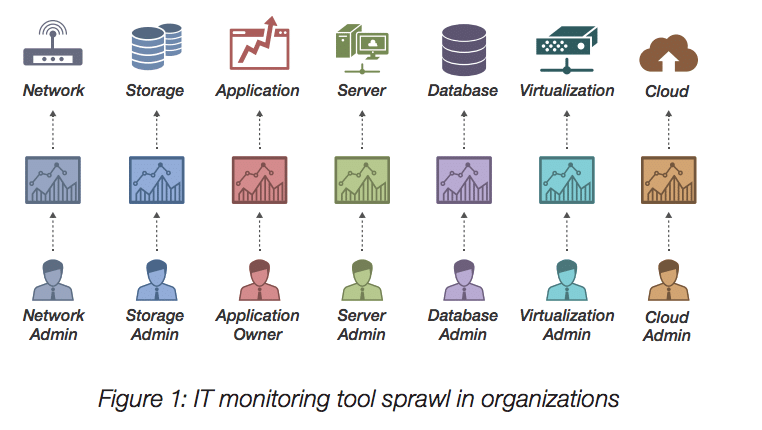How IT Infrastructure Monitoring Can Ramp Up Your Business Capabilities
It’s a common scenario. The IT team is backlogged with incidents that must be resolved, eating up time and taking focus from other important tasks. Even though your IT infrastructure is built well, events will occur. But a reactive approach is certainly the least efficient method to deal with them. Whether your infrastructure is in-house, in the cloud, or some combination thereof, you can benefit from an IT infrastructure monitoring – one that allows a proactive approach to anticipate issues before they become those pesky events, bringing down your business operations.
Table of Contents
Why IT Infrastructure Monitoring is Critical Today
Years ago, IT networks were relatively simple. Today, they are ever-changing, fluid and scalable, in order to keep up with contemporary business demands. Consider just the myriad of devices (BYOD), the constant traffic, addition of new microservices, etc. that put stress on your network, even posing the security issues of attack. Another wrinkle? Monitoring of all those “additions” has traditionally been silo-based, with separate teams having their own monitoring solutions:
Source: Enginnovations
Monitoring each infrastructure component individually means that you may miss important insights. Troubleshooting without proper context is like trying to assemble a 1,000-piece jigsaw without a reference picture. When things go havoc, you will need to assess each silo individually to locate what’s causing the problem. 35% of IT executives agree that having too many tools and dashboards slows down their response to critical issues and identification of the root cause.
To increase speed and effectiveness, you need to create a unified infrastructure management strategy, backed by the necessary number of modern tools that will ensure you have consistent, and immediate access to all data. When these are in place, you can gain the next business benefits and calculate the exact ROI of infrastructure monitoring.
1. Bandwidth Optimization and Savings
The most critical piece in new, more complex network management is related to bandwidth. You must control usage, ensure availability, and make sure that any potential issues are addressed immediately. Without that management, you are eating up more of your budget than necessary and risking network outages that impact your own operations and the needs of your customers/clients.
By using appropriate tools, you can learn how much traffic/bandwidth is being utilized, where congestion points are, etc. so that use can be better planned for. For instance, with proactive bandwidth monitoring, one company managed to quickly determine the root cause of network outages – employees accessing the same video stream – and broadcast it in the conference room to reduce network saturation. In the long run, bandwidth monitoring alone has resulted in over $120,000 in insourced savings.
2. Early Detection of Changes That Could Impact Performance
Even planned changes on the network can affect performance in unexpected ways. And in a busy operation, those changes can occur in seconds, faster than they can be detected using old network monitoring tools. Automated monitoring that tracks changes in tiny time intervals can provide the alerts (and fixes) that a technical support team needs to stave off bad consequences. Obviously, this will reduce downtime.
Here’s one common scenario. A company decides to open up one of its business applications to larger demographics (e.g. in a new market). During the release, application usage increased with user load (as anticipated), but the application response time surged as well, resulting in multiple HTTP 500 errors. Now a business without an infrastructure monitoring system in place would:
- learn about the event through a growing number of support tickets
- scramble to identify what’s causing the issue
- taking a few days to find and patch it up.
A smarter company with a monitoring solution in place would have a readily-available comparison of current end-user experience to its normal baseline. Once the numbers start rising above the threshold, they would have immediately notified the development team. Based on a simple performance breakdown showing server time over its threshold and network time within baseline, the developers would need less time to identify the root cause and fix it in a few hours.
3. Identify Assert Use
You may have in-house server assets. You may also have AWS cloud server assets. And they are utilized at different capacities at different times round the clock. With a state-of-the-art server monitor tool – one that provides both in-house and cloud server monitoring – tech support can automatically identify under- and over-utilized assets. This allows re-distributions that will prevent downtime and those accompanying costs. It also allows longer-term capacity planning.
4. Improve IT Maintenance Schedules
How often did this happen to you? It’s late in the evening and you have this itch to pay your bills online. You access the app to realize that the system is down for “routine maintenance.” This is frustrating to say the least.
Finding the optimal time for maintenance is a common challenge for business. The goal is always to minimize business disruptions with that maintenance. When IT can identify asset usage and traffic patterns, they have the information they need to schedule maintenance within the optimal time slot to reduce downtime.
5. Maximize Application Performance
The biggest problem with applications that don’t perform well is user dissatisfaction. The other problem is that they eat up bandwidth. This situation costs money and time. When performance of applications is consistently monitored, the issues are quickly identified and resolved. Proactive IT DevOps support team will also suggest you how to avoid those repeating events in the future.
6. Support for BYOD Activities
You, like many other businesses, have probably adopted a BYOD approach to your operations. You have staff accessing your systems 24/7 from wherever they may be. And if you don’t have 24/7 IT support to monitor your systems, events can occur with no quick resolution. With the right infrastructure monitoring solution, IT support can analyze the metrics and traffic patterns, and provide for asset allocation times, so that diverse devices can be accommodated.
7. Improve Expansion/Scaling
Any time a business expands – its customer base, its product or service line, or expanding its internal operations by adding branches or remote staff, there is stress on IT infrastructure. When an infrastructure monitoring solution can provide a pre- and post-analysis of that infrastructure, capacity, bottlenecks, asset allocations, etc., then the expansion/scaling can occur with far less stress, whether an in-house or cloud infrastructure network. The goal is that all components survive and thrive and perform well.
8. Internal and External Usage Billing
Every department has a budget. And a part of that budget should include their IT infrastructure usage. With proper monitoring in place, you can assign the right usage to the right departments for better decision-making regarding consumption and resources. This way you will stay on-budget. For externally billed users, the importance is obvious. Monitoring user consumption and being able to show that consumption in an organized way is critical.
9. Acquire and/or Retain More Customers
This is obviously the most important aspect of having an comprehensive IT infrastructure monitoring strategy. High quality service to customers/clients, whether in the form of products or service level agreements means consistent performance of IT infrastructure. That consistency can be provided with the right infrastructure monitoring – one that will allow IT staff to anticipate problems before or at least in the early stages of their development.
The most current infrastructure monitoring is a critical piece of a business operation. There are a number of different strategies worth considering depending on your current needs and future goals. Romexsoft can provide consultation in IT infrastructure improvement ideas and develop a customized automated infrastructure monitoring plan specifically designed for your needs.


